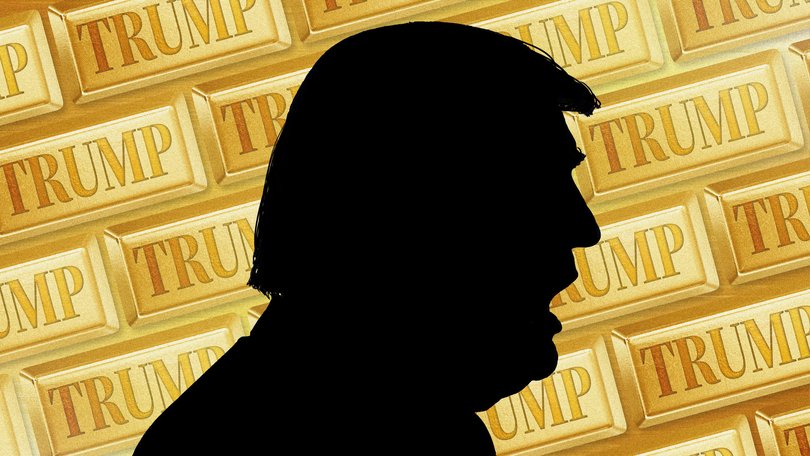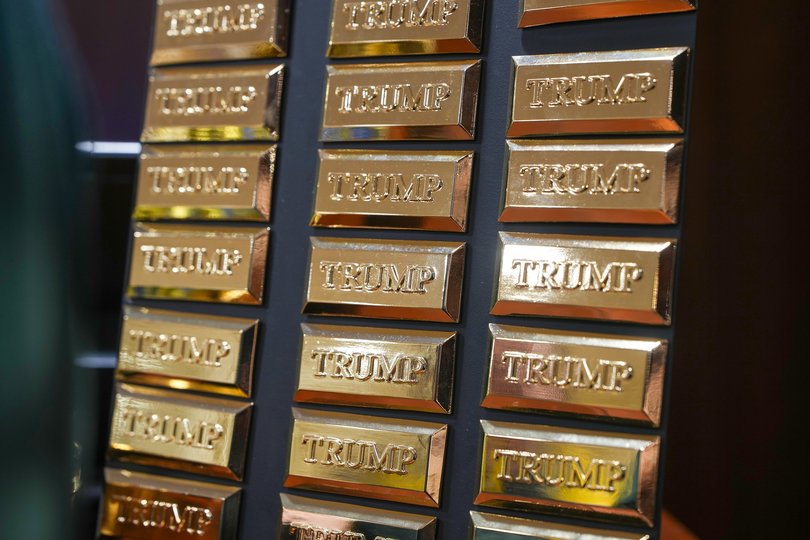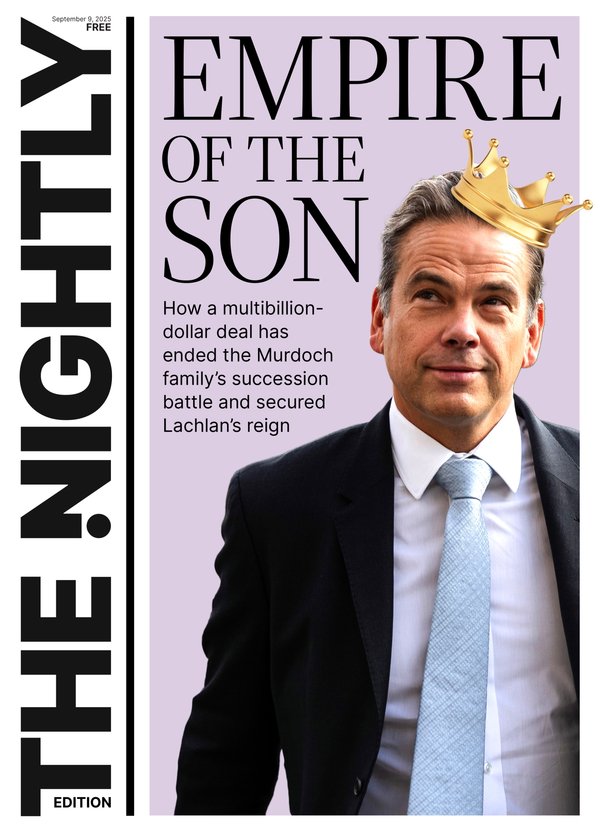US President Donald Trump’s economic policies have made gold sparkle

Gold prices hit a record high today as a stumble in the US jobs market stoked worries President Donald Trump’s economic policies could leading to a broader slowdown.
Many of the economic and geopolitical shifts under Trump are fuelling a global exodus out of US assets into safe-haven alternatives such as gold, according to Romano Sala Tenna a portfolio manager at Katana Asset Management.
“Trump directly and indirectly is responsible (for gold’s rise)” Mr Sala Tenna said. “(The US) will have to print its way out of a debt crisis and the US dollar is undergoing a devaluation that’s leading investors into alternatives.”
Sign up to The Nightly's newsletters.
Get the first look at the digital newspaper, curated daily stories and breaking headlines delivered to your inbox.
By continuing you agree to our Terms and Privacy Policy.Trump’s jobs market is sinking
Jobs data last Friday fuelled worries about the impact of Mr Trump’s tariff wars. The data showed the US economy added just 22,000 jobs in August. Data revised at the time of August’s release also showed the US lost 13,000 jobs in June.
It is possible the US economy lost jobs in July and August, as the revisions to these months have not yet been released and recent revisions have tended to fall lower.
The last time the US lost jobs over a single monthly period (excluding the pandemic aberration of December 2020) was during the Global Financial Crisis and mega-recession of 2008-09.
The past three-month run of average monthly US jobs creation of 29,000 means US employment is now worse than at anytime under Mr Trump’s predecessor, Joe Biden.
These facts undermine Trump’s claims that the US economy is hot. On the contrary, the jobs market is now at its weakest across any recent period excluding the GFC recession of 2008-09 and coronavirus pandemic.
Trump even fired the head of the Bureau of Labour Statistics because he didn’t like July’s jobs data. Mr Sala Tenna said the President’s adversarial nature makes gold more attractive to investors, as an alternative to a potential US dollar softening.
Rate cut bets spur gold’s jump
Another key consequence of the poor jobs data is that interest rate futures traders now price a 90 per cent chance the US Federal Reserve will cut interest rates 25 basis points on September 19 to rescue the jobs market.
Gold tends to rise as interest rates fall. This is because it becomes more attractive as a store of value in the context of cash savings offering lower interest rates to savers.
“Overall, declining rates are a positive for gold,” Mr Sala Tenna said. “A Fed cut in September is all but guaranteed and the big news now is it could be 25 or 50 basis points. I think there’s pros and cons to dropping rates.
“It makes the dollar less attractive and the Fed can control the short end (of government treasury yields), but ultimately the market controls debt levels at long end. If the spreads widen (between yields at the short and long end of debt maturities) it shows less confidence about the US fiscal position.”
The Trumpian economy also means the US central bank is expected to cut rates as inflation rises. This may result in a Keynesian stagflation scenario, where more liquidity, or cheaper borrowing rates fail to proportionately stimulate growth.
In response, over just last the month the gold price has jumped nearly 8 per cent, or $US258 an ounce, to its latest record high on a total market value around $US24.7 trillion.
“So countries like the BRICs (Brazil, Russian, India, China) are in a big push to move away from US dollars,” said Mr Sala Tenna. “But if you run away from US dollars, there are very few alternatives. You can look at Euros, Renimbi, Yen perhaps, but really gold is the main viable alternative.”

Other Western investors and central banks across Eastern Europe sense the writing is on the wall for the US economy and have diversified into safe-haven alternatives such as gold. According to industry body The World Gold Council central banks added 166 tones to reserves in the June quarter and exchange traded fund investors added 170 tonnes over the quarter.
“Central bank buying remains at significantly elevated levels due to ongoing economic and geopolitical uncertainty,” the WGC said in its latest quarterly report. “Our annual central bank survey shows that 95 per cent of reserve managers believe that global central bank gold reserves will increase over the next 12 months.”
Backward tariff war
Mr Trump’s tariff war is also showing signs of derailing the world’s largest economy. The construction billionaire is effectively telling countries it doesn’t want them to send the US cheap goods anymore and doesn’t want them to lend the US Government money at low rates in return for sending them those goods.
The economic principle of US trade deficits funded by overseas investors has been the backbone of the global economy and trade for more than 40 years, although the Trump administration is now seeking to scrap it.
One side effect under the pre-tariff principle is that the US enjoyed roaring stock markets as its blue-chip companies profited from cheap manufacturing in emerging markets. Mr Trump wants to reverse this economic status quo as he repeatedly claims the US is getting “ripped off” and overlooks the record bull runs that have lined the pockets of US stock investors.
US deficits
Mr Trump’s aggressive tariff war has pushed the US trade deficit to a four-month high of $US78.3 billion in July. This is partly as uncertainty has led US companies to pull forward imports to avoid future tariff chaos.
The tariffs were supposed to reduce the trade deficits, but July’s rush to import goods could subtract from the nation’s gross domestic product as a measure of economic growth in the September quarter.
It is not just the US trade deficit signalling stress either. The US budget deficit as a measure of how much the federal government will take in tax revenues versus what it will spend largely on interest, defence, and welfare is now forecast to dramatically widen in 2026 and 2027.
On August 22, ratings agency Fitch forecast the fiscal deficit to expand from 7.1 per cent of GDP in 2025 to 7.8 per cent in 2026.
Fitch blames this fiscal recklessness on the unfunded income tax cuts extended under Trump’s signature One Big Beautiful Act that passed Congress in July.
“The Trump administration has begun implementing its agenda through tax cuts, higher tariffs, increased deportation of illegal immigrants and reduced federal regulations,” Fitch said. “The U.S. has not taken meaningful action to address its large fiscal deficits, rising debt burden, or the looming increase in spending tied to an aging population.”
The message the US is sending global creditors is you’re in trouble if you own US debt. Especially, as Mr Trump repeatedly demands the US Fed lowers interest rates and openly works to stack the central bank’s board with supporters who will do his bidding.
No confidence in Trump
Therefore gold’s surge looks like a vote of no confidence in Trump’s policies. It’s also a vote of no confidence in the US Fed’s pivot to a rate-cutting cycle despite worries around an inflation rebound.
Traditionally a weakening US dollar and rising inflation, meant the Fed should raise interest rates, not lower them. But professional investors like Mr Sala Tenna argue the US cannot afford higher interest rates, as its $US37 trillion debt pile is too large and its spending plans are out of control.
As a consequence of all this, local gold miners listed on the ASX have been the share market’s star performers in 2025 and are something to watch through the rest of Trump’s wrecking ball term.
